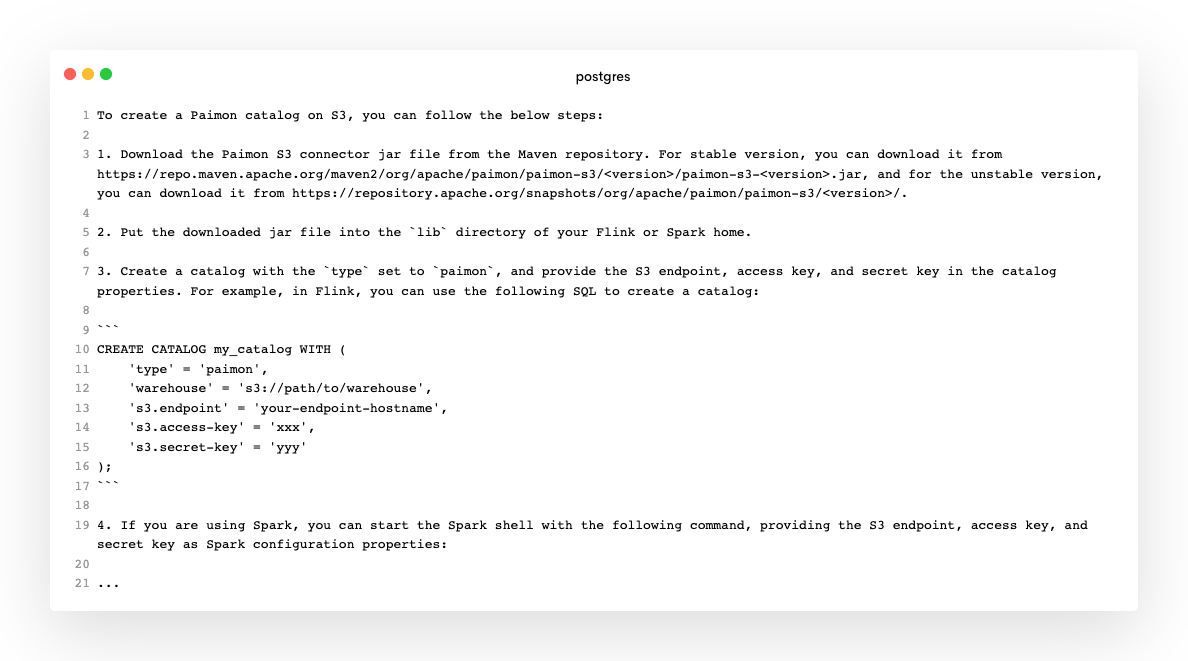Postgres-GPT is a Postgres UDF project that seamlessly integrates Postgres-Vector and OpenAI to establish a SQL-based knowledge repository from Markdown files.
With its document embedding functionality, this project enables users to effortlessly access relevant information directly from multiple documents in a natural language format.
For instance:
-- Generate document embedding
select ai_embedding_doc('/opt/gpt/incubator-paimon/docs', 'paimon');
-- Ask questions to documents in natural language
select ai_ask_doc('paimon', 'How to create a Paimon catalog on S3?');This project was inspired by AskBend and DataBend AI function projects, for which I am very grateful to Databend for their exploration in this area.
To run Postgres-GPT, which is an image that already includes all UDF functions and relevant plugins, you can use Docker.
docker run --name postgres-gpt -p 5432:5432 \
-e OPENAI_API_KEY=<your openai-api key> \
-e POSTGRES_PASSWORD=postgres \
-d yulinying/postgres-gpt
Alternatively, you can use the yulinying/postgres-gpt-playground image that includes pre-embedded sample document data.
Build embedding for automatic document indexing and use natural language queries to return results based on the closest vector cosine distance to a few paragraphs of document content, which are reorganized into natural language answers.
- Build document embedding, where
doc_dirneeds to be changed to a local path accessible by the postgres instance. This process takes a few minutes and needs to be executed only once unless the document changes occur.
select ai_embedding_doc('<doc_dir>', '<doc_name>');- Query documents:
select ai_ask_doc('<doc_name>', 'your question');Explore data that exists in the database using natural language and automatically transform the intention into the corresponding SQL query using metadata from the database.
select ai_to_sql('<your prompt>');yulinying/postgres-gpt-playground is a postgres-gpt image that has been pre-populated with sample data, including embedded documentation for the already constructed apache/incubator-paimon project, and a set of datasets for testing ai_to_sql function.
-- run container
docker run --name postgres-gpt-playground -p 5432:5432 \
-e OPENAI_API_KEY=<your openai-api key> \
-e POSTGRES_PASSWORD=postgres \
-d yulinying/postgres-gpt-playgroundLet's explore these data:
select ai_to_sql('List detailed information for the top 5 companies with the highest event budgets in 2017');
select ai_ask_doc('paimon', 'What is the purpose of the paimon?');
select ai_ask_doc('paimon', 'How to create a Paimon catalog on S3?');Split all markdowns in the specified directory into embedding vectors and automatically store them in postgres.
ai_embedding_doc(doc_dir varchar, doc_table varchar)Parameters:
doc_dir: the local file directory that needs to be built, which postgres can directly access;doc_table: the name of the table where the document embedding is built, which will be automatically created;
Example:
select ai_embedding_doc('/opt/gpt/incubator-paimon/docs', 'paimon');Search for the text closest to the question as a prompt from the vector results stored in doc_table and obtain an answer through openai.
ai_ask_doc(doc_table varchar, question varchar, max_token integer, mode varchar )Parameters:
doc_table: the name of the table where the document embedding has been built;question: the user's natural language question;max_token: the maximum length of the answer text in tokens;mode: the openai model used, which includes the following optional values:v1: Use the text-davinci-003 model based on Completion API;v2(default): Use gpt-3.5-turbo model based on ChatCompletion API;
Example:
select ai_ask_doc('paimon', 'What is the purpose of the paimon?');Generate the corresponding query SQL based on natural language, using metadata in the specified schema.
ai_to_sql(prompt varchar, schema varchar)Parameters:
prompt: the data query requirement described in natural languageschema: target schema name.
Example:
select ai_to_sql('List detailed information for the top 5 companies with the highest event budgets in 2017');
-- result:
SELECT c.name, SUM(cam.monthly_budget) AS total_budget
FROM companies c
INNER JOIN campaigns cam ON c.id = cam.company_id
WHERE cam.updated_at >= '2017-01-01' AND cam.updated_at < '2018-01-01'
GROUP BY c.name
ORDER BY total_budget DESC
LIMIT 5;postgres-gpt is actually composed of a series of pl/python functions that can be easily installed on an existing postgres instance.
- Install the following postgres plugins:
- pgvector
- plpython3u
- Install the following python libraries:
- markdown-it-py
- openai[datalib]
pip install 'openai[datalib]' markdown-it-py- Execute all sql scripts under the postgres_gpt directory on the corresponding postgres database.
docker build .